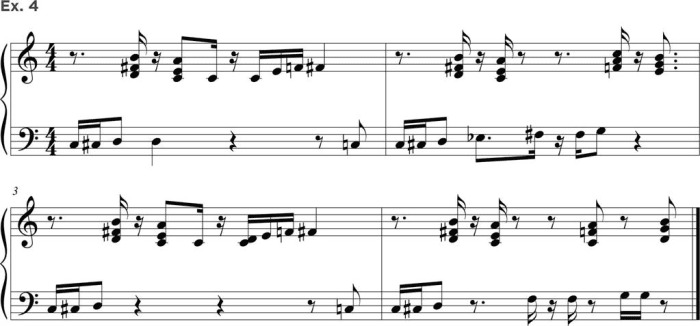How to funk-up your keyboard parts in 5 easy steps
Get funky with this quick guide

Funk demands that you rip up the rulebook and get down to business! For me, this playing style is all about letting go and simultaneously getting locked deep in the pocket. It’s also about working on your time, and a sparse and spacious harmonic approach.
Most of my concepts involve placing the focus on dynamics and rhythm, with the notes themselves taking an important but somewhat of a backseat role. If the groove is there and you leave that all-essential space for the magic to happen, you’re well on your way. Here are some examples to help you improve your funk playing:
1. Rhodes voicings for comping
Because funk generally demands harmony parts that are more sparse than you would use in jazz (dense chords on a Rhodes often sound too muddy for funk), it’s best to keep to three-note chords when supporting right-hand soloing. Ex. 1 is a basic sequence using seventh chords with added ninths. This kind of shape gets used over and over again in the genre and is one that Herbie Hancock uses often on Rhodes. (Check out “Heartbeat” from Herbie’s album Manchild.) This voicing has much in common with rhythm guitar shapes where the root tends to be omitted, and there’s a strong structure with plenty of space for other instruments to work around. The sequence here is C7 add 9, Eb 7 add 9, Bb 7 add 9, C7 add 9. Once you have your hand locked into that shape, practice moving it around left and right of the main chords to add further harmonic interest. Use your thumb on the third to flip between different tonalities. Always practice with a metronome, slowly at first, and then speed up as you get better.

2. Clavinet as rhythm guitar
When approaching the Clavinet for funk music, I always imagine what a rhythm guitarist might play. In. Ex. 2, I’m playing over a one-chord groove in C minor, once again omitting the bass note and playing what’s basically an Eb major 7 chord in my right hand with the G omitted for a sparser, more funky vibe. Practice this by locking your hand in the position, thumb on Eb, the third finger on Bb and fifth finger on D and moving it around the keyboard. You can easily alter the harmony by shifting the whole shape around, or by moving the top or bottom note around step-wise while your hand is locked in position. Practice with a metronome or click and record yourself into your DAW, then examine the matrix editor/piano roll to see how tight you are with the bar divisions.

3. “Question and answer” with one hand
Ex. 3 illustrates a technique I use that I like to call “side-to-side rocking.” It can be done with one hand or between hands, almost as if you were playing congas. You essentially bounce between your thumb and the rest of your hand. Within one hand, I tend to use my second and fifth finger to play a sparse fourth or fifth chord. This poses the “question,” which I then “answer” with a single monophonic phrase using my thumb, second, and third fingers. Don’t play both at the same time: The question is posed first and then the answer is given, although these can be flipped so you play a monophonic line first and answer that with the rhythmic chords. Practice this with a metronome because timing is key! This example is in A minor over a one-chord groove.

4. “Question and answer” with two hands
Ex. 4 divides our previous example between two hands. This demands independence between hands, but they work together to create a killer, funky riff. Again, the rule here is that each hand always plays on its own. This is a great device for Clavinet and Rhodes grooves and it works particularly well across the two manuals of a Hammond organ.

5. Funked-up bass lines
Bass and drums provide the foundation of funk. Just as dictated by the great James Brown, I always make sure that the one, the first beat, is emphasised strongly. A great way to do this is with a slide up or down from whatever note drops on the one, as seen in Ex. 5. You can also try using percussive sixteenth-note “ghosts” between the main bass line notes to add further interest. Perform slides/ glides using your thumb or with your pitch bend wheelset to -12 or -24. Make sure that, after the one, you leave space for other instruments to weave in, and always try to internally vocalize your lines to keep them lyrical. It’s helpful to practice bass lines with your right hand held behind your back as you play along to a solid drum machine beat. This forces you to think lyrically and increases your left hand’s stamina and independence in the process.
Want all the hottest music and gear news, reviews, deals, features and more, direct to your inbox? Sign up here.

“I was introduced to funk through listening to albums by Herbie Hancock, Stevie Wonder, Bernie Worrell’s killer Moog-bass work with Parliament/Funkadelic, Bob James, Larry Dunn (EWF), D’Angelo, Joe Sample and the Crusaders, Patrice Rushen, George Duke, and many others,” says acclaimed UK keyboardist and producer Dan Goldman, aka JD73. The latest JD73 album Make Your Move recently topped the UK Soul Chart and his signature style encompasses jazz, funk, soul, house, disco, broken-beat and electronica.
Listening list: great funk tracks
Herbie Hancock “Spank a Lee” and “Actual Proof,” Thrust
Parliament “Flashlight,” Funkentelechy Vs. the Placebo Syndrome
Tower Of Power “Drop It in the Slot,” Drop It in the Slot
James Brown “Since You’ve Been Gone,” Motherlode
Chaka Khan “I Feel for You,” I Feel for You
Stevie Wonder “Superstition,” Talking Book